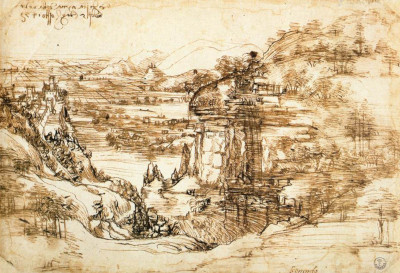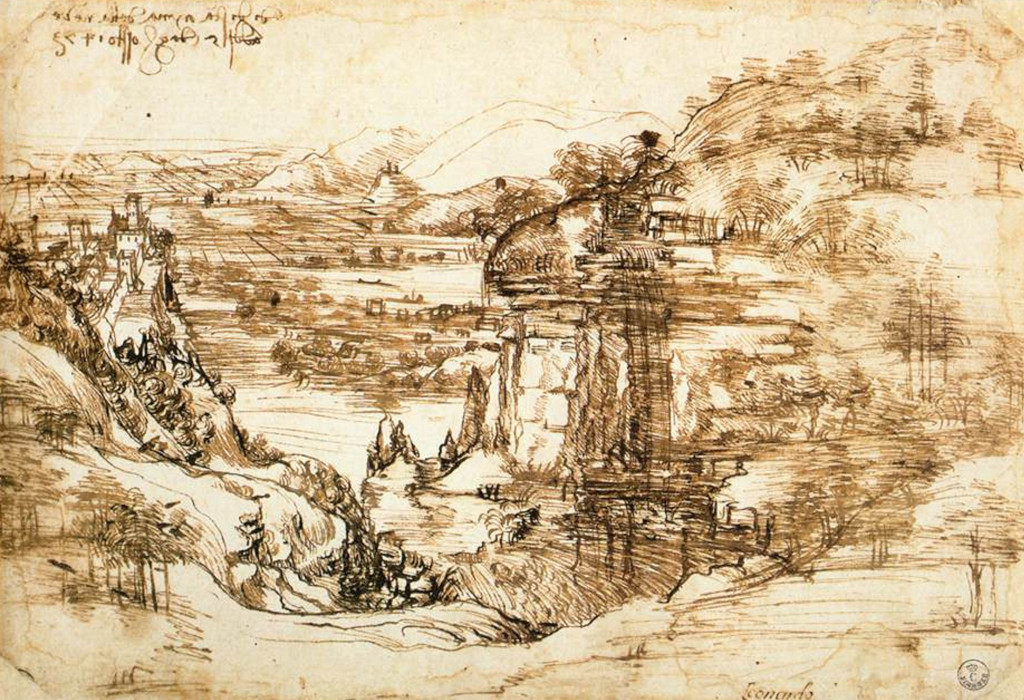 Buy Art Prints Now
Buy Art Prints Nowfrom Amazon
* As an Amazon Associate, and partner with Google Adsense and Ezoic, I earn from qualifying purchases.
Landscape drawing for Santa Maria della Neve, or Arno Landscape, is the earliest pure landscape sketch that we have from the Italian Renaissance. Leonardo would have been in his early twenties at the time that he produced this piece.
Introduction
The artist regularly headed out of the city in order to enjoy the Italian landscape throughout much of his life, and in addition to the aesthetic value of the countryside, he also became interested in the workings of this environment, and how water could effect the land over time.
He would later study natural catastrophies and incorporated some of his knowledge into his engineering designs, such as canal routes. His understanding of landscape composition would also benefit his paintings later on, with many stunning mountainous scenes appearing in the background of a number of his oil works.
Whilst some have claimed that this piece was observed from close to Leonardo's home, studies of geology compared to the composition have suggested that no such regions exist anywhere near where he would have lived at the time. It is therefore more likely that this piece was inspired by his travels, and combined with his own imagination, though debates still rage over this unsolved discussion.
Some have attempted, and failed, to find the same landscape around Florence. We also know that he relied on his imagination in many other genres too, and would often use pen and ink when doing so. Metalpoint was used more so when being disciplined in line, often due to working from observed reality.
This article examines the qualities and content of this drawing, and also underlines its importance within the overall Renaissance, with it being the first pure landscape sketch from that period. There is technical detail about the work, such as its current location, date and medium, whilst we also discuss Leonardo's wider use of landscape themes within both his paintings and drawings.
Arno Valley
The Arno is a famous Tuscan river which cuts inland from the west coast, close to Pisa. The river passes through Florence and it may have been around here that the artist chose to observe the view that we find in front of us here. He was interested in the flow of water, and even later planned a canal route several decades later.
Table of Contents
- Introduction
- Description
- Leonardo's Landscape Drawings and Paintings
- Renaissance's First Landscape Drawing
- Location
- Size and Medium
- Large Image of Landscape drawing for Santa Maria della Neve
- References
Description
This open landscape features a variety of detail, including a small fortified town on the left hand side, and further settlements dotted around the background. The viewer is placed on a hill, looking down, and this environment sweeps around in the nearest foreground. The middle region is fairly flat, leading to hills on the right hand side.
The artist chooses to dot a number of trees across the landscape, normally in small bunches of just a few at a time, and there is also a basic use of perspective with rows of crops in fields. The artist signed the drawing in the bottom right corner, and also added some notes across the sky.
Leonardo uses darker tones in the foreground for this landscape drawing, with lighter tones found beyond, helping to build this impression of distance. Some areas of the composition are not so easy to identify, and perhaps we are witnessing an artist still learning his trade at this point.
Some have claimed that the structure to the left hand side may in fact be Montelupo Castle, and that the artist would have seen it whilst walking around with members of his family, including his uncle. The geological comparisons do not match this region around Florence, however, and so the precise location of this piece still remains a mystery.
Leonardo's Landscape Drawings and Paintings
Leonardo worked on a wide variety of genres whilst an apprentice under Andrea del Verrocchio. He was also exposed to a number of disciplines too, and whilst his style would change once he set up on his own, he would always retain an interest in varying his work. Landscapes would become a part of that, with many drawings completed, as well as elements of landscapes appearing in many of his paintings.
The artist worked from a combination of imagination and observation. He would tend to prefer to use pen and ink when drawing on ideas from his own mind, as this was a more expressive medium as compared to the precise nature of metalpoint. In later life he chose chalk over these alternatives, before spending the last decade of his life combining all of these in different ways.
Da Vinci did not wish to only immitate nature, by replicating its appearance, but he also wanted to understand it. He was particularly interested in the impact of water on the environment and completed a number of scenes of floods and natural disasters, fascinated by the power and impact left behind by such events.
Some have suggested that elements of this scene in front of us here already show the influence of water upon the environment, with a waterfall appearing to the side, and other variations in level impacted by the forces of water in the past. Docuemntation has suggested that the artist was actually visiting this region whilst working, and that most of the scene was based on observation, rather than imagination.
Renaissance's First Landscape Drawing
This drawing, also sometimes known as Arno Landscape, is helpfully dated by the artist as having been produced on the 5th of August, 1473. This makes it the first landscape drawing from the Renaissance era on record. Scenes of nature may have appeared previously, but only as supporting elements within other genres, such as portraiture or religious art.
Location
This sketch from 1473 can be found in the permanent collection of the Uffizi Gallery in Florence, Italy. This respected institution has a specialist department devoted to drawings by the old masters, and that is where this piece can be found. Extra efforts have to be made to protect these items, particularly in terms of lighting, because of their relative fragility in comparison to sculptures and oil paintings.
Size and Medium
Leonardo da Vinci's Landscape drawing for Santa Maria della Neve was produced using pen and ink on paper. The sketch is sized at 28.5 cm in width and 19 cm in height.
Large Image of Landscape drawing for Santa Maria della Neve
This important early piece from the career of Leonardo is shown in closer detail below, with a higher resolution allowing you to appreciate more of the detail added by the artist. The style and composition feel very different to what we expect of Da Vinci, and one would be forgiven for not immediately identifying this piece as one of his own - it is a reminder as to the evolution that he went through, from keen apprentice to innovator.
References
- Leonardo. The Complete Paintings and Drawings, Frank Zöllner & Johannes Nathan, Taschen
- Leonardo da Vinci, Walter Isaacson




